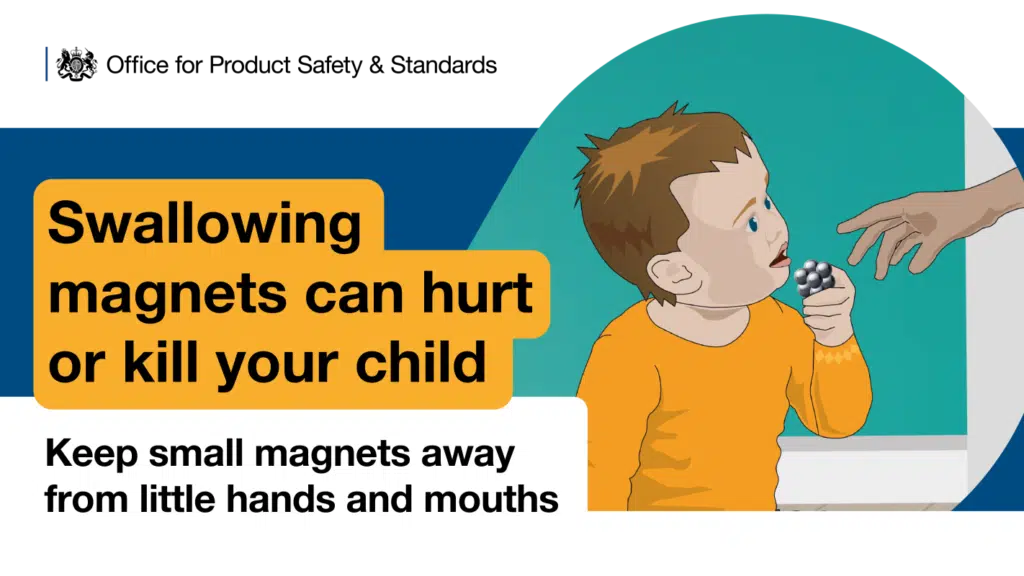14th April 2022
In support of the Office for Product Safety and Standards (OPSS) #NilByMouth campaign, we are delighted to share the second in a series of Voices blogs by Lizzie Tinsley, Senior Sister & Practice Development Nurse, Children’s Emergency Department, The Hillingdon Hospital. This Voices blog focuses on small high-powered magnets.

Lizzie Tinsley, Senior Sister & Practice Development Nurse, Children’s Emergency Department, The Hillingdon Hospital
At the start of the pandemic, we had a two year old arrive in the Emergency Department with a piece of Lego stuck in his throat, which was affecting his breathing. We did an x-ray to establish where in the throat the Lego might be. Fortunately for this toddler, the x-ray included most of his abdomen and, at the bottom of the x-ray, we also found that he had swallowed a number of small magnetic balls. Had the magnets not happened to have been visible on the x-ray, this child could have become critically unwell and potentially died from an injury to his bowel. Fortunately, this child had timely surgery to remove both the Lego and the magnets, and went on to make a full recovery.
High-powered small round magnets have recently become fashionable and are often marketed as “fidget busters” or used in magnetic jewellery, crafts, and puzzles. If swallowed, these small magnets can cause pieces of bowel to become stuck together and this can lead to life-threatening damage to the digestive system.
Whilst there are no official statistics on magnet ingestion in children, many hospitals have been reporting cases to The Royal Society for the Prevention of Accidents (RoSPA). A group of four hospitals in South East England reported 52 cases from 2016-2020, of which 42% required surgery. These hospitals reported a five-fold increase in the number of cases of children swallowing magnets. Since 2019, over 200 cases have now been reported to RoSPA. In particular, there has been an increase in children aged over 10 years of age, possibly due to the prevalence of high-powered magnets in jewellery such as fake tongue piercings and in fidget busters, where groups of these magnets can be formed and reformed into various shapes (RoSPA, 2022).

Picture credit: Gov UK, 2022
Concerns about the safety and prevalence of magnets have reached the Government’s Office for Product Safety and Standards (OPSS) and guidance on toy safety and manufacturing is being reviewed. Parents are being advised by the OPSS that, if there is any chance of the child having swallowed a magnet or if they develop symptoms of fever, vomiting, or abdominal pain, they should attend their nearest Emergency Department immediately if there is any suspicion of magnet ingestion in the last few days (Gov UK, 2022).

Raising awareness of the risks of magnet ingestion with parents is important for reducing life-threatening injuries to the digestive systems of children – and health visitors are ideally placed to do this (please see resources below). Many products are marketed as science and education toys or for use by adults, but commonly end up in the hands of children and teenagers. Unfortunately, the strength of the magnets can cause significant damage to a child but, because they are so small, many parents do not recognise them as a choking hazard so may not seek medical attention if swallowed, as they misconceive the danger that a magnet presents in a child of any age (RoSPA, 2022).
Lizzie Tinsley, Senior Sister & Practice Development Nurse, Children’s Emergency Department, The Hillingdon Hospital
References:
- RoSPA (2022) Magnet Safety | The dangers of magnets and how to avoid incidents – RoSPA [Accessed 10/04/2022]
- GOV UK (2022) OPSS launches magnet safety campaign – GOV.UK (www.gov.uk) [Accessed 10/04/2022]
Resources:
Leaflet – Strong, small magnets can hurt or kill your child
A4 Poster – Strong, small magnets can hurt or kill your child
OPSS is keen for groups, businesses, and individuals to support and share the materials on Twitter, Facebook and Instagram by using the hashtag #nilbymouth.


